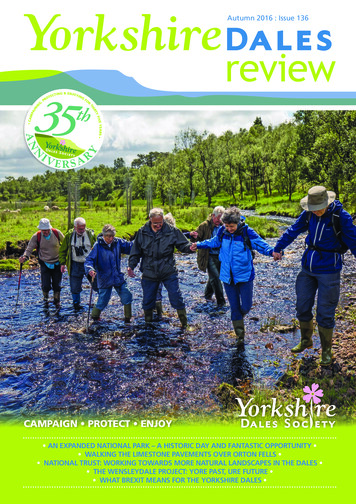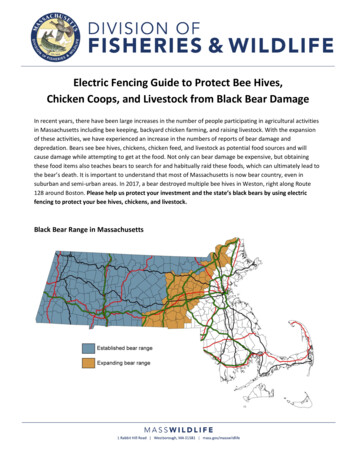
Transcription
TING & ENJOYINTECGFOROP,RGTYIRTHNIVYANYEARS FIVE CAMPAININAutumn 2016 : Issue 136ERSARCAMPAIGN PROTECT ENJOY AN EXPANDED NATIONAL PARK – A HISTORIC DAY AND FANTASTIC OPPORTUNITY WALKING THE LIMESTONE PAVEMENTS OVER ORTON FELLS NATIONAL TRUST: WORKING TOWARDS MORE NATURAL LANDSCAPES IN THE DALES THE WENSLEYDALE PROJECT: YORE PAST, URE FUTURE WHAT BREXIT MEANS FOR THE YORKSHIRE DALES
Cover photo: Intrepid YDS Members cross the stream at Nethergill Farm, photo Tim HancockThis page: Aysgarth Falls, photo David Higgins, The Wensleydale Project, Yore Past, Ure Future, page 8CONTENTS Autumn 2016 : Issue 136AN EXPANDED NATIONAL PARK: Page 3A HISTORIC DAY AND A FANTASTIC OPPORTUNITYWALKING THELIMESTONE PAVEMENTSOVER ORTON FELLSPage 4-5NATIONAL TRUST:Page 6-7WORKING TOWARDS MORE NATURALLANDSCAPES IN THE DALESHELP US TO KEEP THEYORKSHIRE DALES VIBRANT:Page 14THROUGH A LEGACY GIFTNEW YDSBUSINESS MEMBERSPage 14-15HYPERCAST IN THE DALESPage 15CHRISTMAS GIFT OFFERPage 15AN ACT OF FAITHPage 16BOOK REVIEWPage 17OFF TO A GOOD STARTPRIMULA FARINOSA:Page 1735 ANNIVERSARYHIGHLIGHT:THE BIRD'S EYE PRIMROSE ANDOUR SOCIETY LOGOTHE WENSLEYDALE PROJECT:Page 8YORE PAST, URE FUTURECAPTURING THE PAST:Page 9THPage 10-11A VISIT TO NETHERGILL ECO FARMWHAT BREXIT MEANS FORTHE YORKSHIRE DALES2OS MAPS A VERY USEFUL APP Page 13Email: ann.shadrake@yds.org.ukYORKSHIRE DALESSOCIETY'S EVENTSPage 12-13Editor Fleur SpeakmanPage 18-19
AN EXPANDEDNATIONAL PARKA HISTORIC DAY AND A FANTASTIC OPPORTUNITYWarmly greeted by a great crowd of well-wishers, theYorkshire Dales National Park Authority celebratedin style at Orton on August 1st this year, with a varietyof activities for various age groups, as a welcome for anexpanded Yorkshire Dales National Park - achieved after sixlong years. The Park has now officially increased by 24%,with its new areas in Cumbria and Lancashire adding on417 sq km (161 sq miles) to protected landscape.Lord Gardiner, Defra's Parliamentary Under Secretary of State,declared: This is an exceptional achievement, making one of thejewels in the crown of British countryside even bigger and brighter.Tellingly, he continued: I want to acknowledge the stewardship offarmers, landowners and countryside managers and the enormouscontribution they have made to the landscape we see today. Hepointed out, that the Dales and Lakes National Parks between themattracted a combined 20 million visits a year, providing income forlocal small businesses, jobs for local people and also much-neededinvestment in infrastructure. But the gain was not just economic: otherlikely benefits from national parks were improved mental and physicalhealth, the opportunity to taste and buy some excellent local food andto ensure that havens were created for a variety of plants and animals.Many people had worked tirelessly to bring about the expandedNational Park so that some very special and beautiful landscape couldbe appreciated and more easily accessed by more people, but at thesame time, conserved for future generations. When the YDNP wasoriginally established in 1954, administrative and political concernscaused some very distinctive areas to miss the protection they so richlydeserved. Tribute must be paid not just to the two National Parksthemselves, that campaigned for so long for this territory, but also toboth the Friends of the Lake District who initiated the idea and theYorkshire Dales Society, by lobbying so consistently and eloquently;YDS members Malcolm Petyt and Colin Speakman particularly deserveour thanks.As ninety people sat down to an excellent lunch and appropriatespeeches of congratulation, it was notable that the local people mostaffected by the Park expansion had very positive views in the Park'sfavour. A pity that some of the media later felt they had to give air timeto some professional and ill-informed nay-sayers. Funding was not amajor issue; as the 2015 Spending Review had brought the welcomenews that: Funding for national parks has been protected and thatadditional monies are being made available, so that the Authoritycould carry out its responsibilties in the extension area.Carl Lis, Chairman of the YDNPA, emphasised: Today is a truly historicday but the real work starts now. There is a lot to do to ensurethe future growth and vitality of this area and all our objectives Ihave been encouraged by the huge enthusiasm that we have receivedfrom so many organisations, communities and individuals and I lookforward to working together to achieve those objectives.Representation on the Park's Board will now be increased by threenew members from Eden District Council, City of Lancaster andLancashire County Council, following a Government consultation onfuture governance arrangements. The Park had already held severaldrop-in sessions for members of the public and met with parish councilrepresentatives, landowners, farmers and local businesses to explainwhat they do and how they each might be able to help each other.The Yorkshire Dales Review has also introduced the Park's newexpanded territory to our members through its last two issues plus thecurrent issue of the magazine (page 4-5) with a double page spread oftext and some scenic photos. We hope that it will encourage people tovisit those areas and perhaps stay on to explore further in such placesas Orton Fells, the northern Howgills, Wild Boar Fell and Mallerstang.As Natural England's Liz Newton, Director Landscape, Access &Geodiversity, stated: For as long as I can remember, this has beenreferred to as “unfinished business” for Natural England, and today isthe culmination of a lot of hard work by many, that will ensure thatthese special places are given the care and attention they deserve.This truly historic and significant event is also the occasion of afantastic opportunity for the future.Fleur SpeakmanYorkshire Dales Society3
WALKING THE LIMESTONEOur walk took us eastwards from the village and up a gentle climbto Scar Side, passing an old lime kiln and onto the open limestonecountryside with sheep bitten grass and the odd lonely and wizenedhawthorn. A finger post on the Public Bridleway indicating 'Access toMonument', pointed us towards our first objective, which was clearlyvisible at the top of a steepish climb. The Beacon Hill monumentwas erected on 21st June 1887 and its inscription reads: 'This ancientbeacon fire was here kindled to commemorate the jubilee year of thebeneficent reign of her gracious majesty Victoria queen and empress'.The views from this vantage point are stunning and we were fortunateenough, given low cloud, to be able to admire the northern Pennines,Mallerstang, and the magnificent Howgills, the latter which will also bepart of the extended National Park (see Malcolm Petyt’s article in theSummer 2016 Review).Mark with Oscar at Orton CrossI’ve done a lot of walking in the Dales, but I have to admit to neverhaving explored the renowned Scars above Orton. The great newsof the extension of the National Park to include this area providedme with the incentive to put this right and in February this year Iheaded for Orton and got my boots on.Whilst waiting for my walking buddy I had a look around Orton, whichWainwright aptly described as one of Westmorland’s loveliest villages.Incidentally, his 'Coast to Coast walk', which I did many moons ago,passes through the village. Orton, established in the 13th centuryenjoys an idyllic rural location and is blessed with fine amenities,including 'The George Hotel' and 'Kennedy’s Chocolate Factory andCoffee House'. All Saints church is built on higher ground in the villageand its imposing 16th century white tower can be seen from almostanywhere in the surrounding countryside.Orton Scar limestone pavement and Orton Cross4Email: ann.shadrake@yds.org.ukWe were intrigued by the mention of the nearby 'Thunder Stone'on the OS map and set off to find it. Orton and Great Asby Scars aredesignated as open access with only a few designated paths, so it isfun to wander about at will. This is my way of saying that it took usa while to find the aforementioned stone, which, if I’m honest, wasa little underwhelming! It is a modestly sized granite glacial erraticwhich the dry stone wallers of the time had conveniently, and sensibly,incorporated into their wall.We then made for the amazing limestone pavements in the NationalNature reserve of Great Asby Scar. The welcome board to the reserveputs it well when it says: 'This large expanse of limestone pavementand heath present a landscape that offers rare chances of experiencingupland wilderness'. It really is a fascinating, other worldly, landscapeand we had the place to ourselves.
PAVEMENTS OVER ORTONThese limestone pavements were formed from rock laid down ina warm shallow sea some 350 million years ago. During the last iceage some 12,000 years ago, the rock was scoured by a thick ice sheet,which after melting, left behind a layer of glacial debris. Water filteringthrough the debris progressively eroded the deep fissures (grikes)*between the hard upstanding limestone blocks (clints), and eventuallywashed most of the debris away. Limestone pavements are nationallyrare and have been extensively damaged in the past by removal forgarden rockery stone. Great Asby Scar contains some of the bestremaining intact examples in Britain.Given that we visited on a rather bleak winter’s day, there was notmuch evidence of the rich flora that can be seen here in the warmermonths. The limestone pavement is home to rarities such as angularSolomon’s-seal, dark red helleborine, bloody crane’s-bill, rigid bucklerfern and limestone fern. On top of the limestone pavement you canfind other specialities including bird’s-foot sedge, autumn gentian andsalad burnet. Dwarfed trees dot the limestone landscape, their growthstunted by the rock itself and the very dry conditions found here. Partof the reserve is managed as a non-intervention area where no grazingis carried out, allowing such growth. There is also an abundance of birdand invertebrate life in the area. We thought we heard the gutturalcroak of ravens though didn’t, unfortunately, spot any.We then headed south along the Dales High Way and back throughthe pavements, bagging the trig point at Powson Knott, beforereturning to Orton for a pint by the log fire in the George Hotel toreflect on our 12 mile, six hour walk and agreed, that we would bereturning to this special area in future. Oh, and I bought a very nice barof chocolate from Kennedy’s before heading for home.Mark Corner* grikes can also be spelled as grykes.Courtesy of Where2WalkDrystone Wall built around the 'Thunder Stone'Yorkshire Dales Society5
The presentThe National Trust has two large properties inthe centre of the Yorkshire Dales, at MalhamTarn and in Upper Wharfedale, which togethercover over 8,000 hectares. They are beautiful,dramatic and much loved areas with afascinating history and a rich ecology. However,aspects of human exploitation of the land overthe centuries, whilst creating some stunninglandscapes, have also impoverished nature andthe environment.WORKINGTOWARDSMORE NATURALLANDSCAPES INTHE DALESThe whole National Park has a remarkably lowcover of native trees and shrubs (around 1%)and many areas of relatively uniform moorlandor grassland. Phases of more intensive farming,forestry and grouse moor management havealso had serious impacts on the blanket bogpeatlands, on soils and on the ‘hydrology’ –releasing global warming gases and addingto the potential for increased downstreamflooding.The visionThe Trust’s tenant farmers, who carry out thelion’s share of the land management, haveworked closely with us and organisationslike Natural England over recent decades toconserve and enhance the quality of habitatsand species. Much has been achieved, but ithas become clear to us that further action isrequired to create a more natural, diverse andresilient countryside fit for the challenges ofclimate change. This is a beautiful area but itcould be so much better!Achieving this will take time and requirecooperation and openness to change. Some ofthe changes will need trialling and developing,but in summary we are looking at low-inputfarming systems working across landscapeswith more trees and shrubs (in the right places)and restored peatlands and wetlands. Wewant our tenant farmers to be well supportedfor producing a truly excellent environment,alongside very high quality beef and lamb, albeitat reduced quantities.We believe we can look to a future that givesus the best of everything! We want thrivingwildlife, fantastic views, fascinating archaeologyand cultural histories - an environment thatcaptures carbon, slows water flows andconserves soils, is an inspiring place to visit, haslively local communities and that retains viablefarm businesses.Starting changeWe launched the Yorkshire Dales Appeal in2013, mainly to National Trust members, tohelp us tackle the changes required and weredelighted with the response. The appeal raisedwell over 300,000 and was accompanied byoverwhelmingly supportive comments. Withother grants, we now have three major projectsup and running at a cost of over 700,000.The aim of these initial projects is to create areasof more natural, diverse and robust countryside,at the same time as developing a new andconstructive partnership with our tenantfarmers.More diverse, varied habitats including areas ofheath, trees, shrubs and wetland will support agreater variety of flora and fauna and will betterallow for species to move into and through thelandscape with a changing climate. Insteadof losing carbon from eroding peatlands, weexpect carbon to be captured and stored inhealthy bogs, woods and soils. The more naturalwetland systems will slow the flow of water fromthe hills and hopefully play a part in reducingdownstream flood peaks. In addition, webelieve these changes will create an even morebeautiful landscape and, that we will be able toenhance the conservation and interpretation ofimportant cultural and historic features acrossthe properties.Two Volunteers planting Hawthorn and Hazel withingrykes on a section of limestone pavement'Volunteers surveying erosion abovea large peat cliff6Email: ann.shadrake@yds.org.uk
Work started on the ground last year andover the next two years our plans are to havecompleted the following key tasks:1. The planting of over 100,000 trees andshrubs to create new areas of nativewood pasture and scrub. The treeplanting is focussed on the upland gills atDarnbrook within the Malham estate andnear Yockenthwaite in Upper Wharfedale.In addition we are planting shrubs likehawthorn and hazel in and around areasof limestone scar and pavement acrossMalham Moor. [The Malham work issupported by a major grant from WREN’sFCC Biodiversity Action Fund from fundsdonated by FCC Environment through theLandfill Communities Fund.]2. Completing work to restore the conditionof the blanket bog across the Trust’s landin the Dales ( 3,500 hectares of bog).Drains on the bogs were blocked someyears ago and no burning or damaging levelsof grazing have been permitted since theTrust acquired the land. The final phasesof peatland restoration involve working on(reprofiling) the eroding ‘peat hags’ and revegetating any small areas of bare peat. [Thetree planting and peatland work in UpperWharfedale is supported by CountrysideStewardship agreements administered byNatural England.]3. Developing result-based agreements withour tenant farmers. We are in the processof early discussions with a number of tenantfarmers, with the objective of triallinganother way of delivering environmentalimprovements. The intention is to identifythe main components of a healthy naturalenvironment in a given area and todesign payment options for farmers thatdepend entirely on the environmentaloutcomes they deliver – rather than ontheir completion of management tasks.The payments would be designed usingassumptions about how the outcomes arelikely to be achieved, but payments wouldbe made based on the outcomes deliveredin practice, or indicators of progresstowards those outcomes. The approach,and in particular the monitoring, will bekept as simple as possible. We will involveecologists, farmers and rural surveyorsin the design of the payment optionsin order to identify locally appropriateecological outcomes, to achieve practicaloption design and to ensure consistency inapproach and payments across areas.Peter Welsh(National Trust Ecologist, Yorkshire Dales)peter.welsh@nationaltrust.org.ukIf you would like to make a donation to helpwith our work in the Yorkshire Dales, please usethe link T NATIONAL TRUST NEWSAs part of its new on-going vision for landmanagement in the Yorkshire Dales, theNational Trust have recently reintroducedaround 100 specially bred water voles, (a speciesdeclining by almost 90 per cent), to MalhamTarn. The voles will play an important part inthe ecosystem, by grazing and burrowing intoriverbank areas, thus providing space for rareplants to grow. They will also act as a foodsource for such species as barn owls and otters.It is planned to release a further 100 in the fenarea of the tarn in June next year.Diggers have been working along theeroding peat edges and pealing back thevegetation above, reprofiling the erodingpeat edge and then folding back theblanket bog vegetation to completelycover the exposed peat.See water vole photo on back cover, showingspecies reintroduced at Malham Tarn.THE SOCIETY’S FIRST PATRONTrustees have invited Alastair Humphreys,an adventurer and author who grew up inthe Dales, to be the Society’s first Patron.This new role is designed to enable peoplewho have a high profile in the media orpublic life to offer support or advice tothe Society when requested. Mark Cornermet Alastair following an inspirational talkhe gave at Settle early in 2016 about hisunusual and exciting career.Mark explains: Alastair Humphreysis an adventurer, blogger, author andmotivational speaker. As well as expeditionssuch as cycling across the world, walkingacross India and rowing the Atlantic,Alastair was named as a NationalGeographic Adventurer of the Year for hispioneering work on the concept of microadventures: trying to encourage people toget outside, get out of their comfort zone,go somewhere they’ve never been that isclose to home, cheap, simple, short, andyet very effective. Alastair has written eightbooks about his adventures. What's more,Alastair is a young Dalesman with family inAirton, though he now lives in London.Alastair’s latest adventure (summer 2016),is inspired by Laurie Lee’s book As I WalkedOut One Midsummer’s Morning, whichtells of Lee’s walk through Spain in the mid1930s. Lee literally sang for his supper, byplaying the violin and living simply alongthe way. To attempt to recreate this journeyin the 21st century, Alastair learned to playthe violin – as he said in his blog beforesetting out: I have never played music infront of an audience, and it is one of mydeepest fears But is not the essence ofadventure to seek out that which scaresyou? To risk failure and uncertainty? I willnot carry the safety net of spare money orcredit cards: it is the violin or bust.We hope to hear more about inspiringendeavour and Alastair’s unique adventuringspirit, in a future issue of the Review. You canwatch videos of some of his talks at his websitewww.alastairhumphreys.comYorkshire Dales Society7
An ambitious landscapescale project within theheart of the Yorkshire DalesNational Park will be launchedthis autumn. Led by theYorkshire Dales National ParkAuthority and the YorkshireDales Rivers Trust, a partnershipof organisations, businesses,individuals and groups havecome together with the sole aimof improving the environmentof Wensleydale and its tributarydales for the benefit of peopleand nature.The initial inspiration for the project was anidea by local natur
investment in infrastructure. But the gain was not just economic: other . incorporated into their wall. . The limestone pavement is home to rarities such as angular Solomon’s-seal, dark red helleborine, bloody crane’s-bill, rigid buckler fern and











